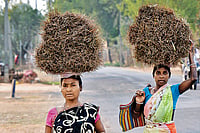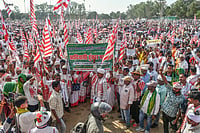“First the papers, then the waiver of the loan.” Not a single week has gone by over the past year when Ramesh (36 years, name changed) has not been told by the Mahila Mandal to bring his wife’s death certificate in order to have her loan waived.
In February 2022, 16 miners, engaged in so-called illegal mining, lost their lives when portions of an open-cast mine in Nirsa, Dhanbad, collapsed on them. Ramesh’s wife Sita (32 years, name changed) was one of the casualties. Ramesh rushed to retrieve her body from the debris and cremated it within hours, to stave off any legal trouble. According to him, the cause of death was suffocation due to being buried under the earth; officially, there was no death.
Ramesh tells Outlook, “We feared police action, so we had to perform the last rites in a hurry. I didn’t know back then that this decision of mine would turn into such a huge problem. Now it appears that my wife's death is nameless and will probably never be verified. Had we got a death certificate made, the Mahila Mandal would have waived off her debt. It was a loan of Rs 40 thousand. The interest keeps piling month by month. I don't make enough to pay it off."
Ramesh's village, situated at a distance of 30 kilometres from the Dhanbad district headquarters, is among the dozens of villages whose land has been rendered infertile by the coal mines. The only means of livelihood therefore is to migrate to the cities as wage labourers, or to extract and sell coal illegally from the abandoned coal mines nearby. The villagers do not speak about their struggles around rations, water, electricity, and housing, but to meet these ordinary needs, they perform something extraordinary. They dig small and narrow wells or pits in the abandoned mines, which they then enter, at great risk to their lives, to extract coal. This process is colloquially called rat-hole mining.
Sita took the same risk so that she could send her two children to a private school to get a good education. After her death, the children stopped going. Ramesh says, “I’ve enrolled them at a government school now. I spend two months at home and then I’m outside (in Goa or Gujarat) for two months. That’s how I manage the children’s care. How could I arrange for their private-school fees, uniform, and expensive books? When Sita was there, she used to bear the expenses of their studies.”
Ramesh reports that Sita used to make around Rs 200 per day by selling coal that she obtained through rat-hole mining.
Rat-hole mining has claimed dozens of lives this year in the Dhanbad district alone. Media reports tell us that in addition to several hundred cases of injuries, there were a minimum of four deaths in March, three in June, three in September, two in October, and one in November.
Outlook spoke to a dozen workers associated with rat-hole mining and several labour organisations to find out how many coal workers fall prey to illegal mining every year; we could not ascertain a definite figure.
For example, in April this year, in Tapin Basti, block Mandu, Ramgarh, Sudhani (38 years, name changed) died after she was buried under debris while mining a rat hole. Her husband had died 15 years ago. Labouring away to provide for her children and meet the household needs somehow, Sudhani joined the ranks of those who die in anonymity. Nobody, not even her children, like to talk about it.
Rat-hole mining feeds thousands of families in Ramgarh and Hazaribagh. Many practise it on the sly in Ramgarh’s Mandu block, which is the site of several abandoned open-cast mining operations. Mandu-based activist Mahalal Hansda tells us that in addition to being buried alive under mining debris, people also die from tuberculosis and asthma induced by coal smoke and dust, and from collisions with trucks on highways when they are ferrying coal on their bicycles. “These labourers have lost their land and forests and have no other source of livelihood. Their only means of survival is illegal mining.”
Unfortunately, even Hansda does not have any definite data on the number of deaths in the area due to illegal coal mining.
Samir Das, member of the Center of Indian Trade Unions, Jharkhand, says that no records can be found of workers who lose their lives to illegal mining. Since it is a prohibited area of work, he explains, it is difficult to organise the people involved, and hence also to collect data about them.
Rupesh Kumar Sahu’s 2022 documentary “Rat Trap”, under the production house “Akhra”, depicts the helplessness of rat-hole miners in Jharkhand and the perils to which they are driven by an acute employment crisis. Sahu tells us that his team did a lot of research before making the film, but could not gather the correct figures pertaining to those who died in the process of rat-hole mining.
Arup Chatterjee, ex-MLA of Nirsa and secretary of Bihar Colliery Kamgar Union, who often raises the issue of workers dying during rat-hole mining, avers that the actual number of such deaths far exceeds those reported in the media. According to him, approximately one lakh workers are engaged in illegal mining in the Dhanbad district alone, and around 2000-2500 people were crushed to death during rat-hole mining in just the last one year.
Chatterjee adds further that rat-hole miners earn Rs 500-600 a day at the most. It is the coal smugglers who buy from these workers and sell to brick kiln owners that make fat profits to the tune of crores. Everyone gets a cut of these profits, right from the party in power down to the various departments of the government.
Chatterjee explains that illegal rat-hole mining is not necessarily restricted to old or abandoned mines: geographically, Dhanbad is so rich in coal that if one digs a 35-feet pit anywhere in the coal hotspot, one strikes coal.
Apart from the 16 victims mentioned earlier, five more people were suffocated to death in February 2022 when a section of the Gopinathpur Colliery in Nirsa caved in on them.
Chatterjee says about this incident, “This was the first time in my 23 years of political activism when the deaths were officially confirmed. What made the difference was that the public became aware in time and we put pressure on the officials to get the post-mortem done, whereas generally in such cases, the news of the incident reaches us long after the workers die, and by then the dead bodies are cremated already.”
“Because of this,” Arup continues, “we could have the death certificates of those five made, and a case was filed against the management of the coal company, which is currently under investigation.”
Alas, Ramesh's wife Sita is not among those five whose deaths could be certified. Ramesh says it has been a year now that he has been pleading with the village head for a death certificate, but he repeatedly turns him away, saying the certificate cannot be made because his wife died during illegal mining, and that he needs to bring the papers from the hospital and the police.
According to government sources, in the absence of a strong policy, people will continue to die in this manner. The question remains, will Sita's name ever emerge from anonymity and enter the ranks of the officially dead, a feat her family has been hoping to achieve for a year now?



























